Nucor will invest $35 million into Helion Energy as part of the deal. Helion Energy has received over $600 million in funding and commitments for another $1.7 billion to develop commercial nuclear fusion.
A few months ago, Helion Energy signed a deal to provide Microsoft with 50 MWe of fusion power by 2028.
This new plant will need to generate five times the 20 kEV per shot to 100 kEV per shot and double firing rate from 10 shots per second to 20 shots per second.
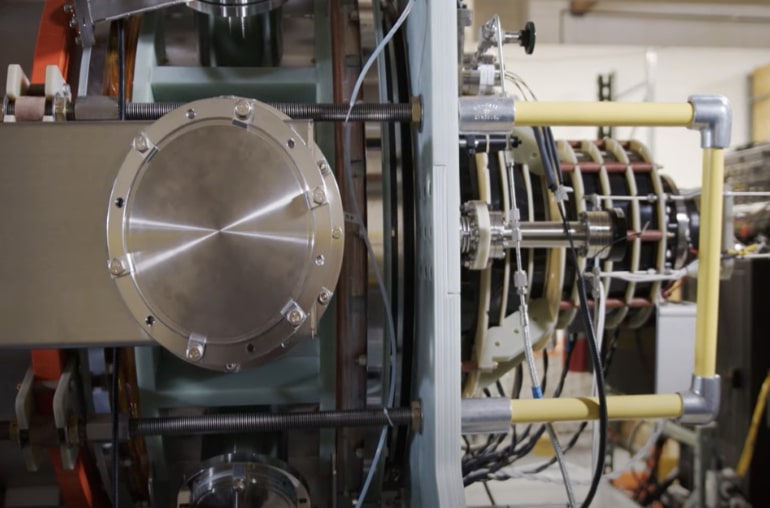
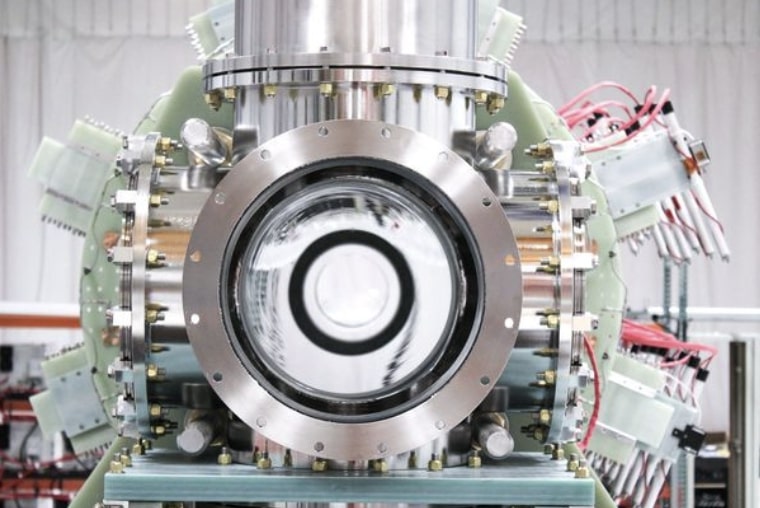
David Kirtley discusses the science and scaling at Helion Energy.
7th prototype Polaris
Helion’s seventh-generation prototype, Project Polaris was in development in 2021, with completion expected in 2024. The device was expected to increase the pulse rate from one pulse every 10 minutes to one pulse per second for short periods.
The goal is to increase the pulse rate to one per second and then to 10 shots per second. This will be 600 to 6000 times more frequent than the previous prototype.
They have already built smaller steady state capacitor systems that have sustained hundreds of shots per second. Helion has had low pulse rate high power systems and high pulse rate low power systems. The Polaris system will bring this together with high pulse rate high power systems.
8th prototype Antares
As of January 2022, an eighth prototype, Antares, is in the design stage.
Hitting the goals for the Microsoft obligations. Helion Energy will need to make Polaris work at 10 pulses per second and then make Antares work with Polaris energy generation and Antares energy capture.
6th system is working at about 10 kEV (10 thousand electron volts). Over 10,000 shots.
7th system will work at 20 kEV. Want to have it operating by the end of 2023.
8th or 9th systems to get to the ideal operating levels of 100 kEV.
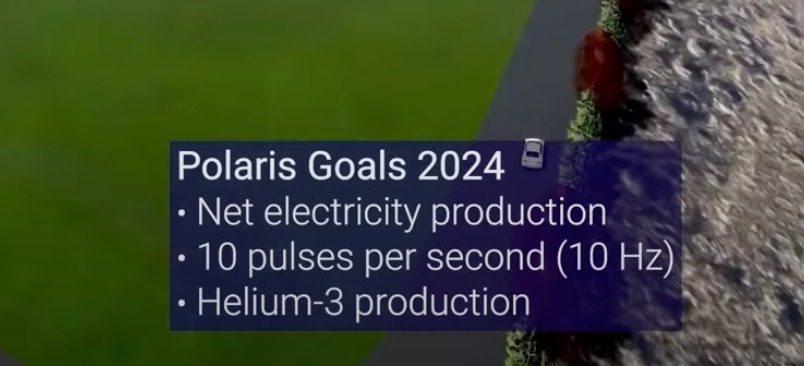
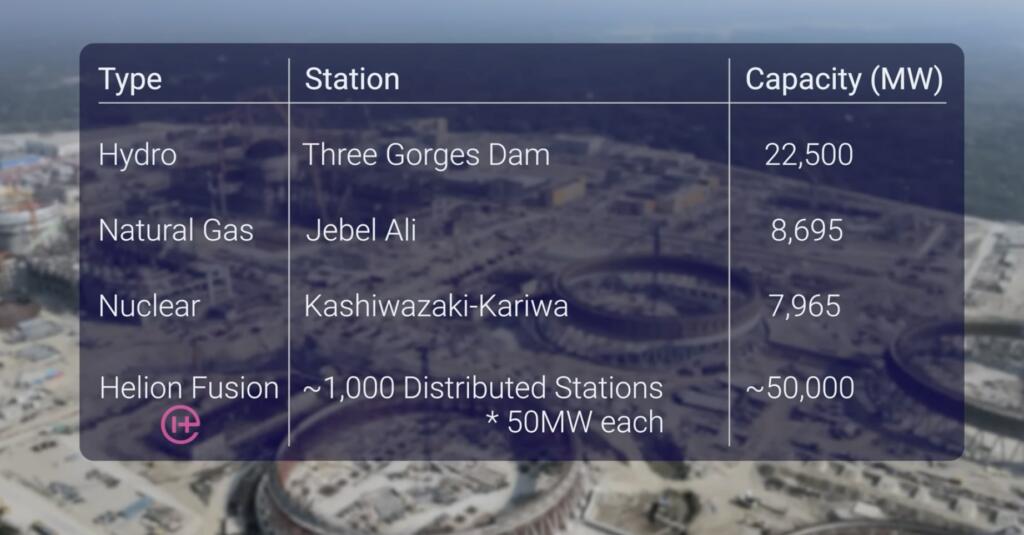
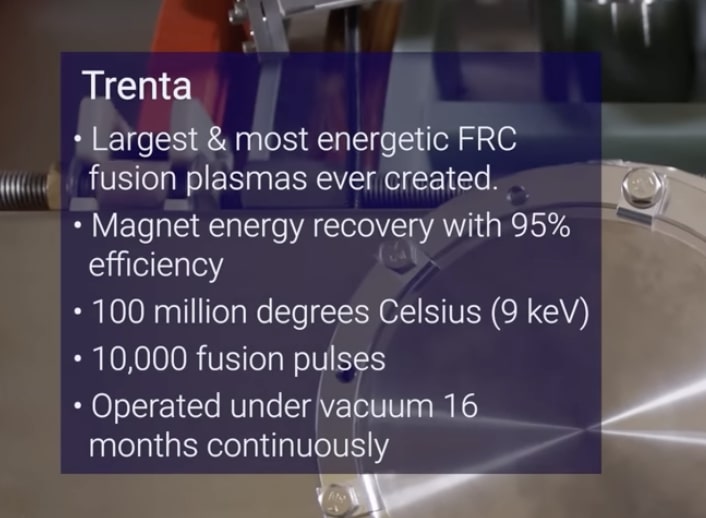

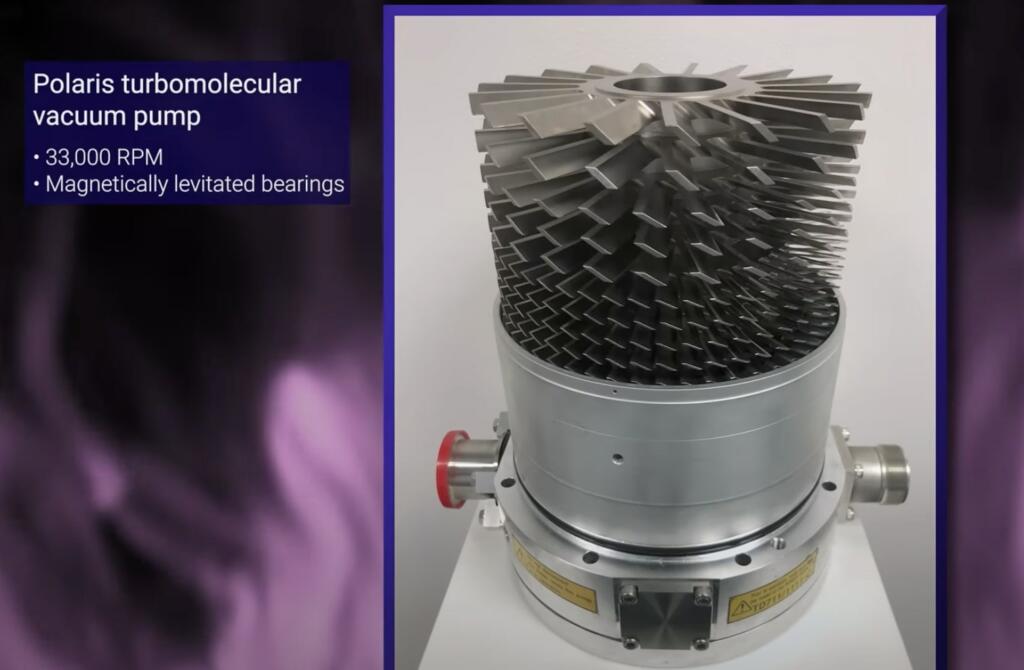



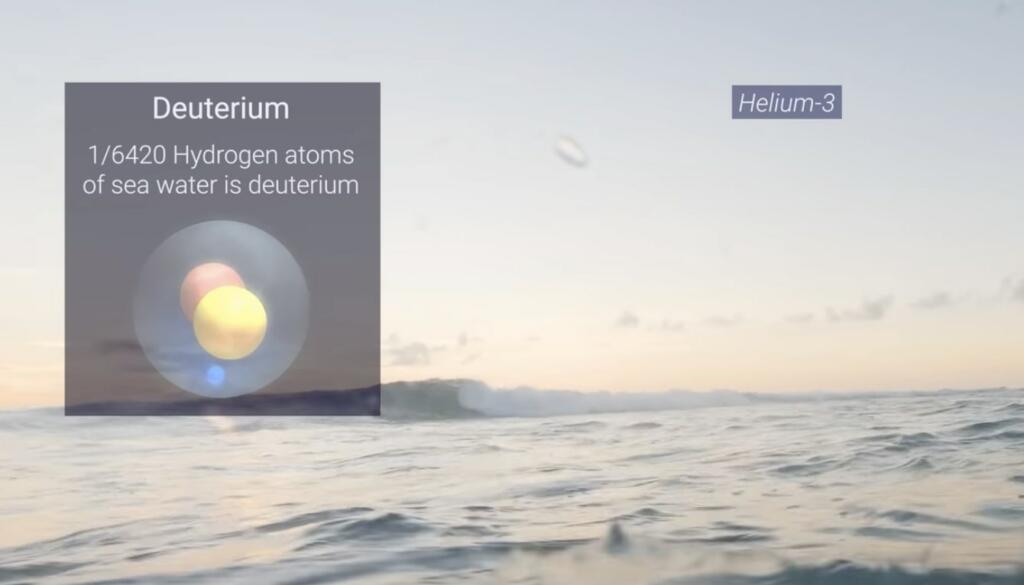





Brian Wang is a Futurist Thought Leader and a popular Science blogger with 1 million readers per month. His blog Nextbigfuture.com is ranked #1 Science News Blog. It covers many disruptive technology and trends including Space, Robotics, Artificial Intelligence, Medicine, Anti-aging Biotechnology, and Nanotechnology.
Known for identifying cutting edge technologies, he is currently a Co-Founder of a startup and fundraiser for high potential early-stage companies. He is the Head of Research for Allocations for deep technology investments and an Angel Investor at Space Angels.
A frequent speaker at corporations, he has been a TEDx speaker, a Singularity University speaker and guest at numerous interviews for radio and podcasts. He is open to public speaking and advising engagements.


“I like fusion and space exploration more than most everyone here but when I see Helium 3 mining in the moon being discussed I generally feel that whatever is being proposed is unrealistic.”
Assuming high demand for said fusion fuel (i.e. Helium 3) that would mean lots of fusion reactors operating; so it might be reasonable to assume fusion rockets existing also. Given fusion rockets being able to get to Saturn or Uranus (foregoing Jupiter because of high radiation levels) in a reasonable amount of time seems likely. As to why he (Foyle) said the “gas giants” rather than the obviously much closer moon the likely reason is concentration. On the moon if I recall the maximum concentration is about ~10-15ppb. Many orders of magnitude more concentrated in the atmospheres of the gas giants. Not only many times total amount available but the much higher concentrations would presumably make extraction less difficult; separating gases vs baking it out of lunar regolith.
Very cool but you forget about distance and gravity there maybe… I dont think getting to the atmosphere of a gas giant is going to be easy with nowaday tech, thats always the thing with profitability, Elon gets this very right with all the companies he has, we live today, not in the future. Going to mine helium 3 on the moon is challenging, on our gasgiant now or in 20 years – no.
Still, you can create He3 with power producing reactors, that run easier reactions than the aneutronic He3 reaction.
D-D fusion produces an He3 nucleus and a neutron half the time, the other half it produces Tritium and a proton.
The neutron from the first chain can be used to produce tritium by intercepting it with lithium. You can even have that high energy neutron multiply by hitting beryllium first.
And Tritium decays into He3 with a half life of about 12 years.
So, sensibly you’d start out with D-D reactors, stockpiling the He3 and Tritium, with the latter producing He3 over time. Frankly, the D-D reaction is easier to pull off anyway.
And later you’d also have He3 reactors, which would require less in the way of radiation precautions, but would be dependent on the D-D reactors for fuel. But they could be deployed with less safety concerns.
Technically, probably easier and more profitable than mining gas giant atmospheres. At least for Earth. Space colonists in the outer solar system might find atmosphere mining preferable.
This is exactly what Helion is doing.
Instead of either mining traces of He3 on moon OR producing HE3 directly in reactors (also good idea suggested by Brett Bellmore) why not design reactors to make tritium and let it decay naturally to HE3 at 5%/year? This was done at the tens of kg per year level for decades. Given sufficient demand hundreds of purpose-built reactors could deliver tons/year. No way space mining of ppb resources could ever be the best way.
[ Why Tesla is not invested in nuclear fusion development? ]
Because Elon is smart
No doubt about that.
ChatGPT estimates a global workforce for nuclear power (including research) being ~400k people (maybe slightly declining numbers with a table requested for 2019-2022). Although no precise numbers possible (acc. to ChatGPT) since not available, for ~2022 is estimated with ~8000-10000 people involved (with increasing numbers from a table for 2019-2022 and global investments ~2.8 billion USD for a year 2022).
another point towards scientific engagement within a keyword ‘Tokamak’:
” We analyzed 25,085 nuclear fusion research papers published during 1976-2016. They were collected from the Scopus database (document type: article) and contain the term “tokamak” [etc.] ”
page 3, ” Table 1. Summary statistics of 14 leading countries in nuclear fusion research.
All values are real numbers as we count the number of papers by the fractional counting method. Ratio is the proportion of collaborative papers to total papers. ”
‘https://www.researchgate.net/publication/330977739_Measuring_national_capability_over_big_science’s_multidisciplinarity_A_case_study_of_nuclear_fusion_research’
about smart
‘https://www.guinnessworldrecords.com/news/2020/10/middle-school-student-achieved-nuclear-fusion-in-his-family-playroom-631163’
Why not being included with nuclear fusion (on a maybe lower scale)?
Look, I like “fusion” as much as the next scientist. It has so much appeal: largely free from long-lived radioactives, abundant-to-essentially-limitless fuel sourcing, possibility of pretty efficient fusion-energy to electrical-energy extraction.
Yet and still … it is 2023 CE.
23 years past the turn of the millennium. Nearly 50 years since fusion experiments were being scaled up at universities and national laboratories all over the planet. Maybe more.
Now, we’re being sold on the idea that Fusion is going to be at the 500 MW plant level, oh, in 7 years?
________________________________________
Color me purple and call me an eggplant.
I would agree that it MIGHT well be possible in the time frame suggested by this article’s summaries, IF AND ONLY IF there were competent day-after-day, month-after-month continuous reactors of similar but smaller scale already working.
But there are not.
Up-selling the idea is “we got pulses every 10 minutes, and now we can get them every few seconds, for a limited period of time.” Does that sound like 7 years to 500 megawatts continuous output? No? Me neither.
________________________________________
Note however, I am NOT SAYING that it is impossible in some timeline that takes into account the 50+ year history of Fusion Research’s propensity to project marvelous futures off reasonably well measured experiments, only to have the scaled subsequent experiments develop gremlins and warts from one source or another.
This is what I expect with the plasma pinch fusion efforts. They may well have pretty darn impressive short-time-frame results now, and reasons to believe that they can harness 600× or 6000× the pulse-rate-and-duration operations just around the corner. Right? But I expect that when the marvelous sub-billion dollar machines are cobbled together there’s going to be a number of gotchas that no one expects.
Does this spell doom? Kind of not, kind of so. It has been the accumulation of mind-bogglingly ingenious ways that plasma has found to thwart Scientist’s efforts to tame it, that has scuttled any hope that ITER would point to a practical next-generation fusion device on the Tokamak design. That durn plasma just seems to keep wiggling out of the ever-more-sophisticated bottles that scientists have used to contain it. Bad plasma. Bad.
________________________________________
On the up-side however, I do like how the entire fusion-cycle is contained in that info-graph up there. Done well, done right. There certainly is some magic in the “how we’re going to separate the components and reactants” in real-time you know. But I think that is an engineering and molecular physics problem, not significantly harder than running any of Intel’s fabulous wafer-fabrication lines.
So, the future is bright.
And VERY newsworthy.
For a long time to come.
Well past 2030.
⋅-⋅-⋅ Just saying, ⋅-⋅-⋅
⋅-=≡ GoatGuy ✓ ≡=-⋅
I expect that the plasma has a finite bag of tricks to escape containment, and eventually it will run out. Eventually.
Anyway, we can build fusion reactors any time we decide to stop futzing around and get serious. We cracked fusion back in the early 1950’s, we just don’t like how big the fuel pellets have to be to make it work. But reactors have been designed that would work at that scale.
OTOH, if we ever decide to stop futzing around and get serious, we’ll put fusion on the back burner, and just build fission reactors… We cracked that problem even earlier, the only reason we don’t do it is we let ourselves be ruled by lunatics.
Fundamentally, nuclear energy isn’t an engineering problem anymore. It’s a political/social engineering problem, instead.
This.^^^
Reality is pretty easy. It only looks hard because of pathological regulators.
People die producing energy every day. Coal mines crush people, gas explosions, wind maintenance techs fall, solar installers fall, biomass contributes to farm deaths.
If all energy technology was held to the same safety standards as fission, all of humanity would starve in the cold.
[ What are the most meaningful and trustworthy governments, with having a greater good in mind, for all time? Guesses, suggestions etc.
Is there improvement within the rules supporting a ‘public welfare’ in general, within governments, seen globally, with evolving into 21. century? (e.g. progress like with UN Millenium Goals ‘https://www.un.org/millenniumgoals/’ ]
Helion look very promising.
The He3 fuel cycle may be viable long term (decades given 12 year half life of Tritium needed to make He3), but clearly need a large amount of Tritium in short term to get up and running, so it will start out with a lot more radioactivity, and will likely need a lot of fission reactors to produce sufficient tritium fuel in short term. This is a technology that will take a long time to scale unless they can make bigger machines to run off pure D-D that needs 10x higher energies than D-T
Will eventually be a good business mining gas giants for He3 and D.
This company is on gen 7 and run gen 6 all workday long. https://youtu.be/_bDXXWQxK38?si=9W_TR_frtcWSbNWX
I like fusion and space exploration more than most everyone here but when I see Helium 3 mining in the moon being discussed I generally feel that whatever is being proposed is unrealistic.
AFAIK Helios still expects to be able to make the Helium 3 they need in their reactor on Earth, but there will end up being a permanent base on the moon in about the same time frame so it isn’t off the table.
“I like fusion and space exploration more than most everyone here but when I see Helium 3 mining in the moon being discussed I generally feel that whatever is being proposed is unrealistic.”
Assuming high demand for said fusion fuel (i.e. Helium 3) that would mean lots of fusion reactors operating; so it might be reasonable to assume fusion rockets existing also. Given fusion rockets being able to get to Saturn or Uranus (foregoing Jupiter because of high radiation levels) in a reasonable amount of time seems likely. As to why he (Foyle) said the “gas giants” rather than the obviously much closer moon the likely reason is concentration. On the moon if I recall the maximum concentration is about ~10-15ppb. Many orders of magnitude more concentrated in the atmospheres of the gas giants. Not only many times total amount available but the much higher concentrations would presumably make extraction less difficult; separating gases vs baking it out of lunar regolith.
$600M. That’s more than 10 years of fuel for a big LWR. Does Helion actually have that cash? Is it spent? Is it laundering? So weird…. $600M. Wat a scam.